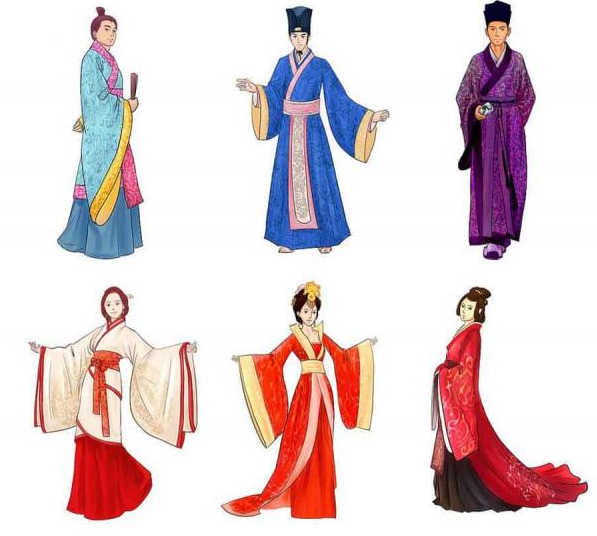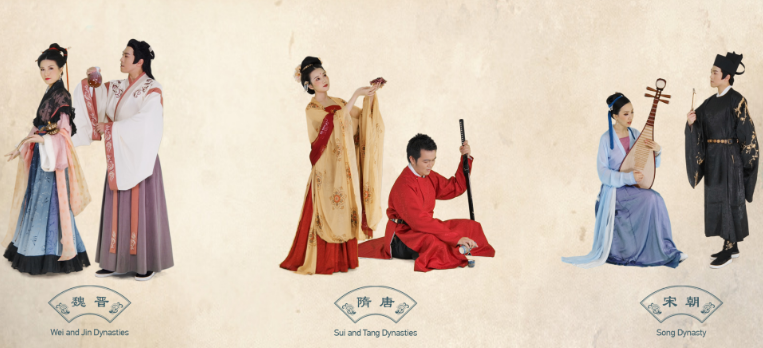Hanfu styles evolved uniquely in each dynasty: Shang and Zhou featured simple designs, Han emphasized formality, Tang introduced luxurious diversity, and Song and Ming favored regional simplicity.
Historical Overview of Hanfu
Hanfu, the traditional attire of the Han Chinese, dates back over 4,000 years, with its origins rooted in the mythological times of the Yellow Emperor and the Yan Emperor. This ancient garb, initially simple in design, quickly evolved to reflect the cultural richness of Chinese society. By the time of the Shang Dynasty (c. 1600–1046 BC), silk production had already reached sophisticated levels, with evidence showing that silk production in China dates as far back as 5000 BC.

Emergence and Evolution of Hanfu in Ancient China
The evolution of Hanfu accelerated during the Shang and Zhou Dynasties. The Zhou Dynasty (1046–256 BC) in particular witnessed the birth of the Shenyi, a pivotal Hanfu style that integrated an upper garment and a lower skirt. Archaeological findings, such as jade carvings and bronze ware from this era, often depict figures dressed in Shenyi, reflecting its prevalence. The Zhou Dynasty’s emphasis on hierarchical social order greatly influenced Hanfu designs, with clothing colors and decorations often indicating one’s social status. For example, during the Western Zhou period, the Duke of Zhou established a detailed dress code where dukes, marquises, earls, viscounts, and barons each wore different colors.
Influences on Hanfu Styles
The geographical diversity of China has always influenced the regional variations in Hanfu styles. In the northern regions, where temperatures often fall below freezing in winter, people traditionally preferred Hanfu made from heavier materials like wool. By contrast, in the warmer southern provinces, lighter fabrics like silk and linen were more common. A study on ancient Chinese textiles indicates that silk production in the south was significantly more advanced than in the north, contributing to these regional differences. Social norms, deeply influenced by Confucian teachings, also dictated Hanfu styles. Confucianism, with its emphasis on ritual and propriety, is evident in Hanfu’s traditional right-over-left lapel design, a feature intended to maintain modesty and decorum.
Throughout China’s history, Hanfu has been more than just clothing; it’s a symbol of cultural identity and social hierarchy. The evolution of Hanfu, from its simple origins to its more elaborate forms in later dynasties, mirrors the historical and cultural progression of Chinese civilization. The study of Hanfu offers a unique perspective into China’s past, providing insights into the societal values and norms of ancient Chinese society.
Hanfu Styles in Specific Dynasties
The styles of Hanfu, the traditional clothing of the Han Chinese, varied greatly across different Chinese dynasties, each reflecting the unique cultural and historical contexts of the era. From the basic forms in the Shang and Zhou Dynasties to the luxurious trends in the Tang Dynasty, Hanfu evolved in design, fabric, and significance, mirroring the changing dynamics of Chinese society.
Shang and Zhou Dynasties
In the Shang (c. 1600–1046 BC) and Zhou (1046–256 BC) Dynasties, Hanfu began to take its basic form. The primary style was the Yi, a narrow-cuffed, knee-length tunic tied with a sash, and the Shang, a skirt worn from the waist down. This period emphasized simplicity and functionality in clothing, reflecting the agricultural lifestyle of the time. Archaeological findings, including oracle bone scripts and bronze artifacts, indicate the prevalence of these styles, with variations mainly in colors and fabrics depending on one’s social status.
Han Dynasty
The Han Dynasty (206 BC – 220 AD) is often considered the golden era of Hanfu. This period saw the standardization of Hanfu styles, which became more elaborate and symbolic. The most iconic Hanfu garment from this era is the Shenyi, a one-piece robe that symbolizes unity and modesty. Historical records show that the Shenyi’s length and the width of its sleeves varied according to the wearer’s social rank, with longer robes and wider sleeves indicating higher status.
Tang Dynasty
During the Tang Dynasty (618–907 AD), China experienced a cultural renaissance, and this was vividly reflected in Hanfu styles. Influenced by interactions with foreign cultures along the Silk Road, Tang Dynasty Hanfu became more diverse and luxurious. Women’s clothing, in particular, became more ornate, with wide sleeves and high waistlines. The “Hufu” or foreign-style robes also gained popularity, showcasing the cosmopolitan nature of Tang society.
Song and Ming Dynasties
The Song (960–1279 AD) and Ming (1368–1644 AD) Dynasties saw a shift towards simplification and practicality in Hanfu. The Song Dynasty favored narrower sleeves and straighter cuts, reflecting the government’s emphasis on Confucian values and simplicity. In the Ming Dynasty, styles varied significantly across regions, influenced by local climates and cultures. This era also marked the rise of distinctively patterned fabrics, with each region developing its unique textile patterns and techniques.
Comparative Table of Hanfu Styles Across Dynasties
| Dynasty | Key Garment Styles | Fabric and Patterns | Cultural Influences |
|---|---|---|---|
| Shang and Zhou | Yi (tunic) and Shang (skirt) | Simple, solid colors | Agricultural, hierarchical society |
| Han | Shenyi (one-piece robe) | Silk with symbolic patterns | Confucian ideals, social hierarchy |
| Tang | Wide sleeves, high waistlines | Luxurious, diverse fabrics | Silk Road, foreign influences |
| Song and Ming | Narrow sleeves, straight cuts | Regional patterned fabrics | Confucian values, regional diversity |
This table provides a concise comparison of the distinctive Hanfu styles across four major Chinese dynasties, highlighting the evolution of this traditional attire in response to changing societal norms and cultural influences.
Hanfu Materials and Fabrication Techniques
The art of making Hanfu, traditional Chinese clothing, involves a rich variety of materials and sophisticated fabrication techniques. These materials and methods have evolved over centuries, reflecting the technological and cultural advancements of each era.
Traditional Textiles and Dyes
Initially, silk dominated the textile scene in ancient China, a testament to its long-standing sericulture. The discovery of silk dates back to around 2700 BC, attributed to the legendary figure, Leizu. Silk, known for its luster and delicacy, was highly prized and often reserved for the upper class and nobility. By the time of the Han Dynasty (206 BC – 220 AD), China had developed a comprehensive range of silk fabrics, including various weaves like damask and brocade.
The use of linen and hemp became more prevalent in the common populace, especially in regions where silk was less accessible. Dyes also played a crucial role in Hanfu’s appeal. Natural dyes, derived from plants, minerals, and even insects, were common. For instance, the use of indigo for blue and madder root for red was widespread. The Tang Dynasty (618–907 AD) saw the introduction of more vibrant colors and patterns, reflecting the period’s opulence and cultural diversity.
Tailoring Techniques and Decorative Patterns Across Dynasties
Hanfu tailoring techniques were as varied as the dynasties themselves. The early Shang (c. 1600–1046 BC) and Zhou (1046–256 BC) dynasties favored simple cuts and minimal stitching, suitable for the agrarian lifestyle of the time. By the Han Dynasty, tailoring had become more sophisticated, with the introduction of techniques like pleating and layering.
Embroidery became a significant decorative element in Hanfu during the Tang Dynasty. Artisans would intricately stitch patterns of dragons, phoenixes, and floral motifs, symbols of good fortune and high status. The Song (960–1279 AD) and Ming (1368–1644 AD) Dynasties brought about more subtle and refined embroidery, often depicting scenes from nature or classical literature.
The fabrication techniques of Hanfu not only demonstrate the technological advancements of each period but also serve as a canvas for expressing cultural values and artistic sensibilities. The intricate patterns and sophisticated tailoring techniques are a testament to the rich cultural heritage of China. For a deeper understanding of these techniques, one can explore various textile museums and historical records, which provide a comprehensive view of the evolution of Hanfu across different Chinese dynasties.

Cultural and Social Significance of Hanfu
Hanfu, more than just a traditional Chinese attire, carries profound cultural and social significance. It symbolizes China’s long history and rich cultural heritage, reflecting the values, beliefs, and norms of Chinese society throughout various dynasties.
Hanfu as a Reflection of Social Hierarchy and Rituals
Throughout ancient China, Hanfu served as a clear indicator of social hierarchy. During the Han Dynasty (206 BC – 220 AD), specific colors, fabrics, and designs of Hanfu were strictly regulated according to one’s social status. For instance, only the emperor was allowed to wear dragon motifs and the color yellow, which symbolized imperial authority. In the Zhou Dynasty (1046–256 BC), a detailed dress code established by the Duke of Zhou further emphasized this hierarchical structure.
Hanfu also played a crucial role in traditional rituals and ceremonies. During the Confucian rituals, specific types of Hanfu were worn to show respect and adherence to cultural norms. For example, during the ‘Capping Ceremony’ (a coming-of-age ritual), young men would wear specific Hanfu garments, symbolizing their transition to adulthood.
The Revival of Hanfu in Modern Times
In recent years, there has been a significant revival of Hanfu, driven by a growing interest in traditional culture among China’s younger generations. This resurgence is not just about fashion; it’s a way to reconnect with and celebrate Chinese heritage. Surveys indicate that the Hanfu movement has gained substantial momentum, with online communities and Hanfu enthusiast groups rapidly growing in numbers.
This modern adoption of Hanfu often integrates contemporary fashion elements, creating a blend of ancient tradition and modern style. The revival also reflects a broader trend of cultural nostalgia and a desire to preserve and promote Chinese cultural identity in an increasingly globalized world. Annual events like the “Hanfu Parade” have become popular, drawing participants from various age groups and backgrounds, all united by their appreciation for this traditional attire.
The enduring significance of Hanfu in both historical and contemporary contexts highlights the deep connection between clothing and cultural identity. Hanfu, more than just fabric and thread, serves as a living narrative of China’s past, present, and future, continually evolving while maintaining its roots in tradition. For more insights into the cultural impact of Hanfu, exploring cultural studies and historical texts can offer a deeper understanding of this iconic attire’s role in Chinese society.







